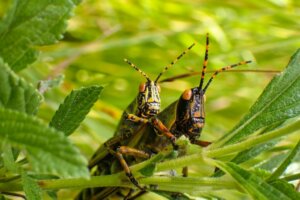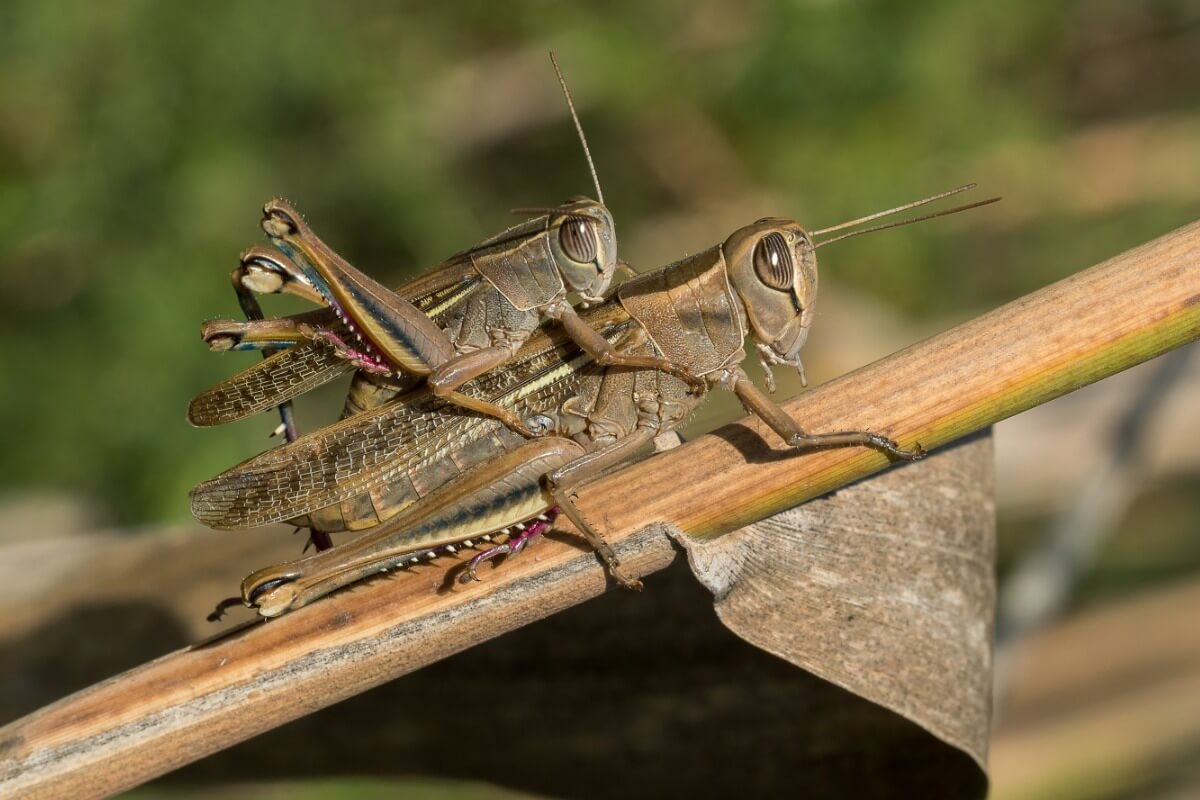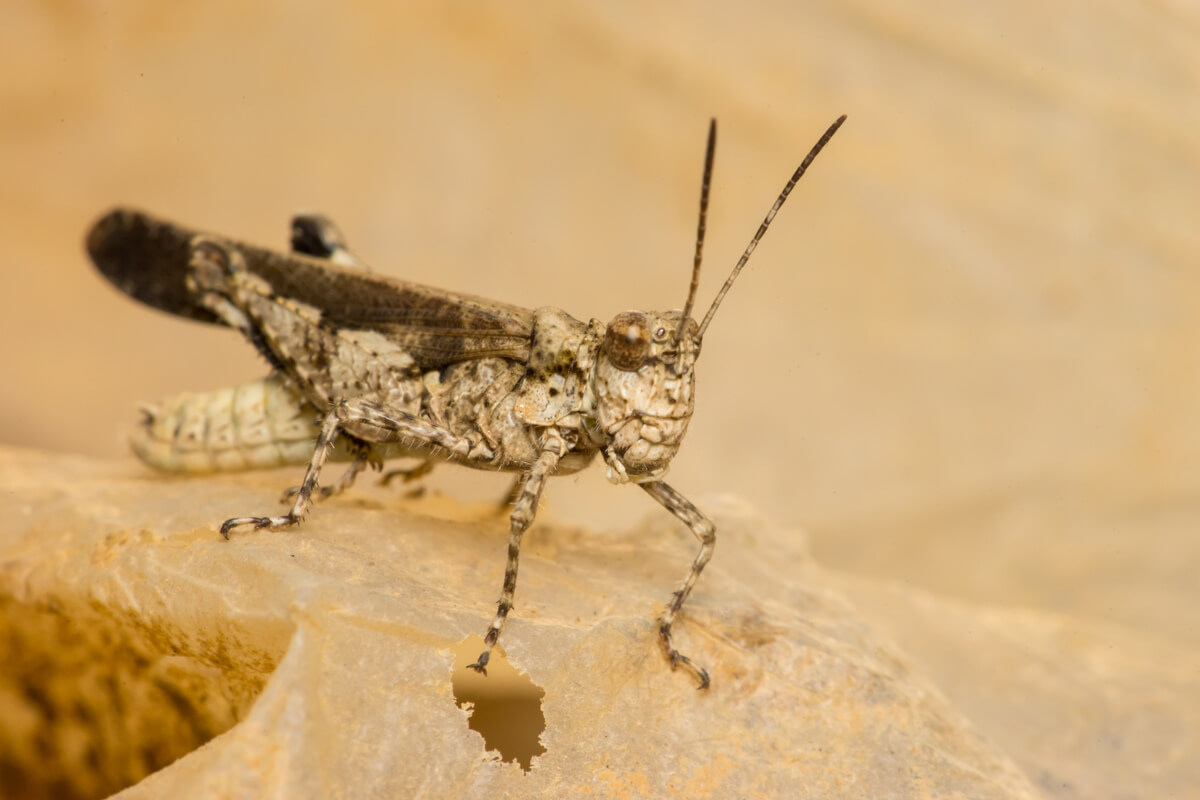All About Grasshoppers: Reproduction and Birth


Written and verified by the biologist Samuel Sanchez
Grasshoppers are very interesting invertebrates from both a physical and ethological point of view. These insects inhabit various parts of the world and are herbivores, which is why they’re classified as pests in regions where they proliferate too much. Despite their destructive potential, it’s worth studying their life cycle. Keep reading to find out all about grasshoppers!
Knowing about grasshoppers and how they’re born and reproduce isn’t only essential to eliminate pests, but is also required to preserve the vulnerable species in their group. Although they’re sometimes annoying, they’re essential pillars of ecosystems. Here we’ll tell you all about the life cycle of these multifaceted insects. Don’t miss it!
All about grasshoppers
First of all, it should be noted that grasshoppers are insects belonging to the order Orthoptera. As such, they share a higher taxonomic group with crickets and wetas. They all have a similar body shape, although habits and dimensions vary greatly between genera and families.
At a taxonomic level, the term grasshopper refers to any insect belonging to the Orthoptera suborder Caelifera. This group includes more than 12,000 species divided into 2400 genera, figures that only attest to its enormous biodiversity. It should be noted that this taxon also includes migratory locusts, although we will not dwell on them in this article. Find out more about them, and the differences between them and grasshoppers in this article.
Grasshoppers have the typical body structure of (almost) all insects: a head with an antennae, eye apparatus, and mandibles; a thorax with 3 pairs of legs and 2 pairs of wings; and an abdomen with 11 segments and the reproductive organs. However, they stand out for having extremely long hind legs with a great driving force.
These insects are considered polyphagous and include a large variety of food in their diet. Most grasshoppers feed on the stems, leaves, tender shoots, seeds, and grains of a huge variety of vegetables, but a few also feed on decaying animal tissues and vertebrate feces.
A grasshopper can cover almost 80 centimetres (over 30 inches) in a single jump. If humans had this ability, they would be able to cross a football field with a single jump.

How do grasshoppers reproduce?
The males of many species spend much of the day “singing” (actually the process is called stridulation) to attract females when conditions are right, i.e. if it’s warm and isn’t raining. They generate the movement by friction between their hind legs and toothed wing structures.
In most cases, males attract females and climb on top of them to fertilize them without much hassle. There are some exceptions to this rule, such as the strategy of the species Kosciuscola tristis, native to Australia. In this case, several males try to reach the back of the same female and push, grab, and even bite each other.
Once the male is on top of the receptive female, he inserts his aedeagus (an intromittent copulatory organ) into the abdominal end of his mate. In this way, he transmits a spermatophore containing viable sex cells to her. The sperm fertilizes the eggs by traveling through channels known as micropyles.
During copulation, the male remains attached to the female on her back through his abdomen.

How are grasshoppers born?
While the males compete or search for females, the females gain weight and begin to mature the eggs inside their bodies. After reproduction, the fertilized mother makes a hole in the ground with the help of her ovipositor (the organ in charge of laying the eggs) and delicately places the eggs inside. This usually occurs in spring-summer.
The number of eggs laid per female each time varies according to the species, but professional sources estimate an oviposition interval of 7 to 30 pods with 8-30 eggs inside each pod. In general, the fertilized mother will lay an average of 100 eggs throughout the reproductive season. She must hurry, as her life expectancy isn’t usually more than a year.
Once the female has laid her eggs, she covers them with earth and leaves the place.
The hatching of the young
The hatching of the young depends on the area of origin of the grasshopper species. After a few weeks of development, the eggs often go into a type of hibernation called diapause in order to withstand the cold of winter. Once the temperatures taste, the hatchlings or nymphs emerge with a body structure similar to that of adults, but with a much smaller size.
Depending on the climate, the eggs may hatch in a few weeks or up to 9 months. Almost all nymphs hatch simultaneously.
Grasshoppers are hemimetabolous and only go through 3 stages in their life: egg, nymph, and adult. This means that they “skip” the larva or worm stage, a life stage that other insects (butterflies, ladybugs and flies, among others) do have. Even so, nymphs must molt their exoskeleton 5 times to reach the adult and reproductively viable stage.
Molting is the most vulnerable and difficult process for any insect. In it, the small grasshoppers must separate from their external skeleton and synthesize a new one in order to continue growing. Newly molted specimens are fragile and their cuticle must harden over time. This process requires high relative humidity in most cases.
In the last stage the grasshoppers develop wings. Thus, you can tell more or less the age of an adult by the presence of these structures on its dorsal region.

Knowing about grasshoppers and how they’re born and reproduce is essential to eliminate agricultural pests, but also to understand how ecosystems function. These invertebrates are the food base of many animals (micromammals, reptiles, amphibians, birds, arachnids, fish, and more) and it’s essential to preserve them in order to maintain environmental food chains.
Grasshoppers are very interesting invertebrates from both a physical and ethological point of view. These insects inhabit various parts of the world and are herbivores, which is why they’re classified as pests in regions where they proliferate too much. Despite their destructive potential, it’s worth studying their life cycle. Keep reading to find out all about grasshoppers!
Knowing about grasshoppers and how they’re born and reproduce isn’t only essential to eliminate pests, but is also required to preserve the vulnerable species in their group. Although they’re sometimes annoying, they’re essential pillars of ecosystems. Here we’ll tell you all about the life cycle of these multifaceted insects. Don’t miss it!
All about grasshoppers
First of all, it should be noted that grasshoppers are insects belonging to the order Orthoptera. As such, they share a higher taxonomic group with crickets and wetas. They all have a similar body shape, although habits and dimensions vary greatly between genera and families.
At a taxonomic level, the term grasshopper refers to any insect belonging to the Orthoptera suborder Caelifera. This group includes more than 12,000 species divided into 2400 genera, figures that only attest to its enormous biodiversity. It should be noted that this taxon also includes migratory locusts, although we will not dwell on them in this article. Find out more about them, and the differences between them and grasshoppers in this article.
Grasshoppers have the typical body structure of (almost) all insects: a head with an antennae, eye apparatus, and mandibles; a thorax with 3 pairs of legs and 2 pairs of wings; and an abdomen with 11 segments and the reproductive organs. However, they stand out for having extremely long hind legs with a great driving force.
These insects are considered polyphagous and include a large variety of food in their diet. Most grasshoppers feed on the stems, leaves, tender shoots, seeds, and grains of a huge variety of vegetables, but a few also feed on decaying animal tissues and vertebrate feces.
A grasshopper can cover almost 80 centimetres (over 30 inches) in a single jump. If humans had this ability, they would be able to cross a football field with a single jump.

How do grasshoppers reproduce?
The males of many species spend much of the day “singing” (actually the process is called stridulation) to attract females when conditions are right, i.e. if it’s warm and isn’t raining. They generate the movement by friction between their hind legs and toothed wing structures.
In most cases, males attract females and climb on top of them to fertilize them without much hassle. There are some exceptions to this rule, such as the strategy of the species Kosciuscola tristis, native to Australia. In this case, several males try to reach the back of the same female and push, grab, and even bite each other.
Once the male is on top of the receptive female, he inserts his aedeagus (an intromittent copulatory organ) into the abdominal end of his mate. In this way, he transmits a spermatophore containing viable sex cells to her. The sperm fertilizes the eggs by traveling through channels known as micropyles.
During copulation, the male remains attached to the female on her back through his abdomen.

How are grasshoppers born?
While the males compete or search for females, the females gain weight and begin to mature the eggs inside their bodies. After reproduction, the fertilized mother makes a hole in the ground with the help of her ovipositor (the organ in charge of laying the eggs) and delicately places the eggs inside. This usually occurs in spring-summer.
The number of eggs laid per female each time varies according to the species, but professional sources estimate an oviposition interval of 7 to 30 pods with 8-30 eggs inside each pod. In general, the fertilized mother will lay an average of 100 eggs throughout the reproductive season. She must hurry, as her life expectancy isn’t usually more than a year.
Once the female has laid her eggs, she covers them with earth and leaves the place.
The hatching of the young
The hatching of the young depends on the area of origin of the grasshopper species. After a few weeks of development, the eggs often go into a type of hibernation called diapause in order to withstand the cold of winter. Once the temperatures taste, the hatchlings or nymphs emerge with a body structure similar to that of adults, but with a much smaller size.
Depending on the climate, the eggs may hatch in a few weeks or up to 9 months. Almost all nymphs hatch simultaneously.
Grasshoppers are hemimetabolous and only go through 3 stages in their life: egg, nymph, and adult. This means that they “skip” the larva or worm stage, a life stage that other insects (butterflies, ladybugs and flies, among others) do have. Even so, nymphs must molt their exoskeleton 5 times to reach the adult and reproductively viable stage.
Molting is the most vulnerable and difficult process for any insect. In it, the small grasshoppers must separate from their external skeleton and synthesize a new one in order to continue growing. Newly molted specimens are fragile and their cuticle must harden over time. This process requires high relative humidity in most cases.
In the last stage the grasshoppers develop wings. Thus, you can tell more or less the age of an adult by the presence of these structures on its dorsal region.

Knowing about grasshoppers and how they’re born and reproduce is essential to eliminate agricultural pests, but also to understand how ecosystems function. These invertebrates are the food base of many animals (micromammals, reptiles, amphibians, birds, arachnids, fish, and more) and it’s essential to preserve them in order to maintain environmental food chains.
All cited sources were thoroughly reviewed by our team to ensure their quality, reliability, currency, and validity. The bibliography of this article was considered reliable and of academic or scientific accuracy.
- Aedeagus, an Overview. Sciencedirect. Recogido a 17 de noviembre en https://www.sciencedirect.com/topics/agricultural-and-biological-sciences/aedeagus
- A Guide to Grasshopper Control in Yards and Gardens. Recogido a 17 de noviembre en https://extensionpublications.unl.edu/assets/html/g1633/build/g1633.htm
- Aeropedellus clavatus, ADW. Recogido a 17 de noviembre en https://animaldiversity.org/accounts/Aeropedellus_clavatus/
This text is provided for informational purposes only and does not replace consultation with a professional. If in doubt, consult your specialist.








